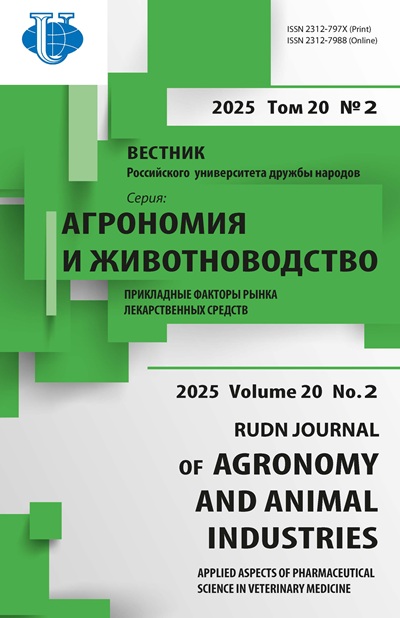Новый набор праймеров для специфичной амплификации ITS-локусов рДНК Ditylenchus destructor
- Авторы: Махмуди Н.1,2, Неджад Д.К.3, Шаянмер Ф.4
-
Учреждения:
- Российский университет дружбы народов
- Всероссийский центр карантина растений
- Семнанский университет
- Университет Тарбиат Модарес
- Выпуск: Том 15, № 2 (2020)
- Страницы: 150-158
- Раздел: Защита растений
- URL: https://agrojournal.rudn.ru/agronomy/article/view/19563
- DOI: https://doi.org/10.22363/2312-797X-2020-15-2-150-158
- ID: 19563
Цитировать
Полный текст
Аннотация
Разработана методика идентификации нематоды Ditylenchus destructor , основанная на использовании различных праймеров для проведения полимеразной цепной реакции (ПЦР). Два универсальных рибосомных праймера были амплифицированы во внутренней транскрибируемой области спейсера ITS-рДНК. Секвенирование продуктов ПЦР подтвердило полиморфизм между видами. Праймеры достаточно чувствительны, чтобы генерировать определенную полосу правильного размера (300 п.н.) из ДНК-матрицы определенной стадии развития D. destructor . Скринингом популяций D. destructor из Ирана и Российской Федерации проверена надежность праймеров, и ожидаемый размер полосы был получен для всех тестируемых популяций. Близкородственные виды Ditylenchus destructor также были протестированы, и специфической имплифицированной полосы не было выявлено. Результаты исследований показали, что данные разработанные праймеры могут использоваться для количественной оценки плотности D. destructor в клубнях картофеля.
Ключевые слова
Об авторах
Нилоуфар Махмуди
Российский университет дружбы народов; Всероссийский центр карантина растений
Автор, ответственный за переписку.
Email: niloofarmahmoodi@ymail.com
аспирант агробиотехнологического департамента, Аграрнo-технологический институт
г. Москва, Российская Федерация; Московская область, Российская ФедерацияДавуд Картули Неджад
Семнанский университет
Email: Kartooli58@gmail.com
доцент кафедры лесоводства, факультет исследований пустынь
г. Семнан, ИранФатиме Шаянмер
Университет Тарбиат Модарес
Email: niloofarmahmoodi@ymail.com
кандидат наук, факультет природных ресурсов
г. Тегеран, ИранСписок литературы
- Abebe E, Mekete T, Thomas WK. A critique of current methods in nematode taxonomy. African Journal of Biotechnology. 2011; 10(3):312-323.
- Blok VC, Powers TO. Biochemical and molecular identification. In: Perry RN, Moens M, Star J. (eds.) Root Knot Nematodes. 1st ed. London: CABI International; 2009. p. 98-112.
- Castagnone-Sereno P. Meloidogyne enterolobii (=M. mayaguensis): profile of an emerging, highly pathogenic, root-knot nematode species. Nematology. 2012; 14(2):133-138. doi: 10.1163/156854111X601650
- Nega A. Review on nematode molecular diagnostics: From bands to barcode. Journal of Biology, Agriculture and Healthcare. 2014; 4(27):129-153.
- Jeszke A, Budziszewska M, Dobosz R, Stachowiak A, Protasewicz D, Wieczorek P, et al. Comparative and Phylogenetic Study of the Ditylenchus dipsaci, Ditylenchus destructor and Ditylenchus gigas Populations Occurring in Poland. Journal of Phytopathology. 2014; 162(1):61-67. doi.org/10.1111/jph.12161
- Nowaczyk K, Obrepalska-Steplowska A, Gawlak M, Throne JE, Olejarski P, Nawrot J. Molecular techniques for detection of Tribolium confusum infestations in stored products. J Econ Entomol. 2009; 102(4):1691-1695. doi: 10.1603/029.102.0437
- Subbotin S, Maafi ZT, Moens M. Molecular identification of cyst-forming nematodes (Heteroderidae) from Iran and a phylogeny based on ITS-rDNA sequences. Nematology. 2003; 5(1):99-111. doi: 10.1163/156854102765216731
- Vovlas N, Troccoli A, Palomares-Rius JE, De Luca F, Cantalapiedra-Navarrete C, Liebanas G, et al. A new stem nematode, Ditylenchus oncogenus n.sp. (Nematoda: Tylenchida), parasitizing sowthistle from Adriatic coast dunes in southern Italy. Journal of Helminthology. 2016; 90(2):152-165. doi: 10.1017/S0022149X14000947
- Gutierrez-Gutierrez C, Palomares-Rius JE, Cantalapiedra-Navarrete C, Landa BB, Esmenjaud D, Castillo P. Molecular analysis and comparative morphology to resolve a complex of cryptic Xiphinema species. Zoologica Scripta. 2010; 39(5):483-498. doi: 10.1111/j.1463-6409.2010.00437.x
- Vrain TC, Wakarchuk DA, Levesque AC, Hamilton IR. Intraspecific rDAN restriction fragment length polymorphism in the Xiphinema americanum group. Fundam Appl Nematol. 1992; 15(6):563-573.
- Marek M, Zouhar M, Douda O, Mazakova J, Rysanek P. Bioinformatics-assisted characterization of the ITS1-5.8S-ITS2 segments of nuclear rRNA gene clusters, and its exploitation in molecular diagnostics of European crop parasitic nematodes of the genus Ditylenchus. Plant Pathology. 2010; 59(5):931-943. doi: 10.1111/j.1365-3059.2010.02322.x
- Subbotin SA, Madani M, Krall E, Sturhan D, Moens MJP. Molecular diagnostics, taxonomy, and phylogeny of the stem nematode Ditylenchus dipsaci species complex based on the sequences of the internal transcribed spacer-rDNA. Nematology. 2005; 95(11):1308-1315. doi: 10.1094/PHYTO-95-1308
- Vovlas N, Troccoli A, Palomares-Rius JE, De Luca F, Liébanas G, Landa BB, et al. Ditylenchus gigas n. sp. parasitizing broad bean: a new stem nematode singled out from the Ditylenchus dipsaci species complex using a polyphasic approach with molecular phylogeny. Plant Pathol. 2011; 60(4):762-775. doi: 10.1111/j.1365- 3059.2011.02430.x
- Pethybridge SJ, Gorny A, Hoogland T, Jones L, Hay F, Smart C, et al. Identification and characterization of Ditylenchus spp. populations from garlic in New York State, USA. Tropical Plant Pathology. 2016; 41(3):193- 197. doi: 10.1007/s40858-016-0083-7
- Subbotin SA, Moens M. Molecular taxonomy and phylogeny. In: Perry R, Moens M. (eds.) Plant Nematology. Wallingford, UK: CABI Publishing; 2006; p. 33-58.
- Fand BB, Nagrare VS, Deshmukh V, Naikwadi BV, Gokte-Narkhedkar N, Waghmare VN. A simple and low-cost laboratory rearing technique for pink bollworm, Pectinophora gossypiella (Suanders) (Lepidoptera: Gelechidae) using detached green bolls of cotton. Phytoparasitica. 2019; 48:25-33. doi: 10.1007/s12600- 019-00779-2
- Liu B, Mei Y, Zheng J. Species-specific detection of interpopulations of Ditylenchus destructor. J Zhejiang Univ. 2007; 33:490-496.
- Wendt KR, Vrain TC, Webster JM. Separation of three species of Ditylenchus and some host races of D. dipsaci by restriction fragment length polymorphism. Journal of Nematology. 1993; 25(4):555-563.
- Chizhov VN, Borisov BA, Subbotin SA. A new stem nematode, Ditylenchus weischeri n. sp. (Nematoda: Tylenchida), a parasite of Cirsium arvense (L.) Scop. in the Central Region of the Non-Chernozem Zone of Russia. Russian Journal of Nematology. 2010; 18(2):95-102.
- Esquibet M, Grenier E, Plantard O, Abbad Andaloussi F, Caubel G. DNA polymorphism in the stem nematode Ditylenchus dipsaci: Development of diagnostic markers for normal and giant races. Genome. 2003; 46(6):1077-1083. doi: 10.1139/g03-72
- Kerkoud M, Esquibet M, Plantard O, Avrillon M, Guimier C, Franck M. Identification of Ditylenchus species associated with Fabaceae seeds based on a specific polymerase chain reaction of ribosomal DNA-ITS regions. Eur J Plant Pathol. 2007; 118:323-332. doi: 10.1007/s10658-006-9092-6
- Zouhar M, Marek M, Douda O, Mazakova J, Rysanek P. Conversion of sequence-characterized amplified region (SCAR) bands into high-throughput DNA markers based on RAPD technique for detection of the stem nematode Ditylenchus dipsaci in crucial plant hosts. Plant Soil Environ. 2007; 53(3):97-104.
- Oliveira RD, Santin ÂM, Seni DJ, Dietrich A, Salazar LA, Subbotin SA, et al. Ditylenchus gallaeformans n. sp. (Tylenchida: Anguinidae) - a neotropical nematode with biocontrol potential against weedy Melastomataceae. Nematology. 2013; 15(2):179-19.
Дополнительные файлы















